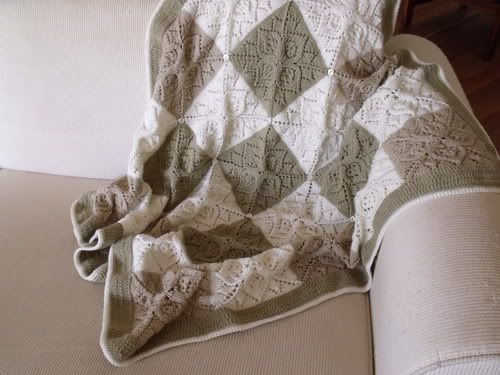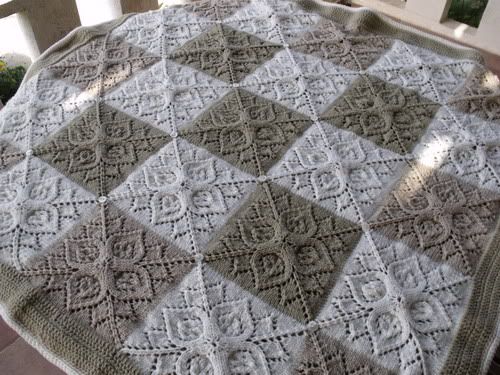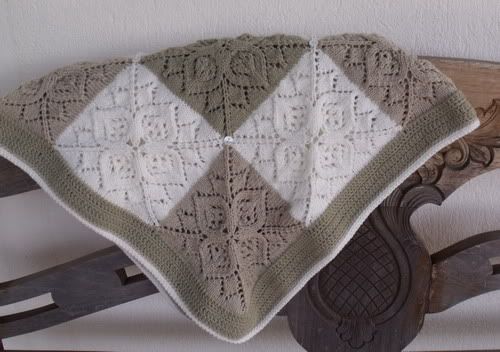Anyone surfing in the net looking for a particular book must have come across the amazing online book shop, The Mad Samplar ... This is no attempt to introduce what probably is already known, but mention and highly recommend the exceptional first class service provided by the owner, Paige ... I have traded with them a few times and shall always return back. They now also have a new division with needlework patterns, fabrics, fibers and other needlework supplies ... Worth a visit if you are looking for craft books, OOPs with very reasonable prices and as I said, with a warm and efficient service as a bonus :)
Sunday, February 28, 2010
Friday, February 26, 2010
Carolyn Dowdell
A fascinating article about Carolyn Dowdell ... This is not a recent story but I thought I'd share it with you, with those who have not heard of it ... Very interesting and indeed amazing!
Thesis project stitches together image of the past
By Ileiren Poon, ExpressNews Staff
Carolyn Dowdell talks about her thesis work:
March 11, 2009 - Edmonton-Unwashed, huddled by candlelight and sewing lavish gowns using only a needle, thread and her own worn fingers, a University of Alberta student has recreated the working conditions of a typical 18th-century seamstress and the fine garments she would have turned out for more fortunate women.
"It was long, and hard, sometimes grueling, sometimes painful, and very, very tiring," said Carolyn Dowdell, a master's student in the Department of Human Ecology.
"My hands got really sore. The set of stays, those were really tough. It's a really high concentration of sewing, and you're sewing through several layers. The stays are made up of wool satin, and behind that there are two layers of a linen canvass. So, you're making the boning channels through all those three layers. Then the bottom of the stays is bound with leather, and that's sewn through all of those layers. I was using pliers to pull the needle through."
Driven by a self-admitted obsession with sewing, Dowdell has spared no detail for her thesis project, authenticating six 300-year-old ensembles and the harsh working conditions of their makers. Even so, producing the complicated outfits in five months would have landed her in hot water during the period she was replicating-between 1750 and 1770.
"If I had been a seamstress back then, working at this pace, I would have been fired," Dowdell laughed. "One of these individual ensembles would have been done in about a week, so all these outfits would have been done in about a month. But those women would have been working even longer hours than I was putting in-12 to 18 hours a day, six days a week."
Following a trip last summer to view antique gowns in the prestigious Museum of London, Dowdell has been working almost every day in her cramped basement apartment to complete the collection of hand-sewn gowns. Toiling only by natural daylight or candle glow, pinched by a tight corset and wearing a plain work dress she made herself, Dowdell sat for hours in a hard wooden chair armed only with a thimble, cutting and stitching natural silks and wools true to the fabrics of the period.
"I wanted to get an idea of the physicality of doing this kind of work in the 18th century, even down to the sanitary conditions, which didn't allow for much bathing," said Dowdell. "These seamstresses were early career women, really, and this project is a way of recognizing their backbreaking work as well as the sumptuous fashions of the time."
All of the pieces are incredibly detailed with handmade, thread-covered buttons, one quilted skirt with about 25,000 tiny hand-done stitches, full ruffles and delicately scalloped edging.
"These are appropriate clothing choices for a middle-class English woman from that time period-merchant class, lower gentry, or clergy," she said. "She wouldn't have been working, but she wasn't wealthy."
The styles wouldn't have changed much as the social status of the wearer changed, said Dowdell. "It's a question of what they're made of-more luxurious fabrics, brocades, embroidery, silver gilt thread and jewels. Those were the things that cost money and showed how much had been spent on clothing. The cost for the labour that went into the pieces was almost nothing."
...
Thesis project stitches together image of the past
By Ileiren Poon, ExpressNews Staff
Carolyn Dowdell talks about her thesis work:
March 11, 2009 - Edmonton-Unwashed, huddled by candlelight and sewing lavish gowns using only a needle, thread and her own worn fingers, a University of Alberta student has recreated the working conditions of a typical 18th-century seamstress and the fine garments she would have turned out for more fortunate women.
"It was long, and hard, sometimes grueling, sometimes painful, and very, very tiring," said Carolyn Dowdell, a master's student in the Department of Human Ecology.
"My hands got really sore. The set of stays, those were really tough. It's a really high concentration of sewing, and you're sewing through several layers. The stays are made up of wool satin, and behind that there are two layers of a linen canvass. So, you're making the boning channels through all those three layers. Then the bottom of the stays is bound with leather, and that's sewn through all of those layers. I was using pliers to pull the needle through."
Driven by a self-admitted obsession with sewing, Dowdell has spared no detail for her thesis project, authenticating six 300-year-old ensembles and the harsh working conditions of their makers. Even so, producing the complicated outfits in five months would have landed her in hot water during the period she was replicating-between 1750 and 1770.
"If I had been a seamstress back then, working at this pace, I would have been fired," Dowdell laughed. "One of these individual ensembles would have been done in about a week, so all these outfits would have been done in about a month. But those women would have been working even longer hours than I was putting in-12 to 18 hours a day, six days a week."
Following a trip last summer to view antique gowns in the prestigious Museum of London, Dowdell has been working almost every day in her cramped basement apartment to complete the collection of hand-sewn gowns. Toiling only by natural daylight or candle glow, pinched by a tight corset and wearing a plain work dress she made herself, Dowdell sat for hours in a hard wooden chair armed only with a thimble, cutting and stitching natural silks and wools true to the fabrics of the period.
"I wanted to get an idea of the physicality of doing this kind of work in the 18th century, even down to the sanitary conditions, which didn't allow for much bathing," said Dowdell. "These seamstresses were early career women, really, and this project is a way of recognizing their backbreaking work as well as the sumptuous fashions of the time."
All of the pieces are incredibly detailed with handmade, thread-covered buttons, one quilted skirt with about 25,000 tiny hand-done stitches, full ruffles and delicately scalloped edging.
"These are appropriate clothing choices for a middle-class English woman from that time period-merchant class, lower gentry, or clergy," she said. "She wouldn't have been working, but she wasn't wealthy."
The styles wouldn't have changed much as the social status of the wearer changed, said Dowdell. "It's a question of what they're made of-more luxurious fabrics, brocades, embroidery, silver gilt thread and jewels. Those were the things that cost money and showed how much had been spent on clothing. The cost for the labour that went into the pieces was almost nothing."
...
Thursday, February 25, 2010
Muguet & Porte Bonheur - Lily of the Valley
After a long long break, I finally have two new designs, added to my page ... They could be purchased at :
&
Wednesday, February 24, 2010
Tuesday, February 23, 2010
Monday, February 22, 2010
Meet Gönül Paksoy
From the book Timeless Simplicity by RHM ...
... As to Gönül Paksoy designs, if you are wearing one, you will be singled out as the bearer of a work of art. Her designs are the harmonious reflection of the past and the future. Paksoy uses old or new handwoven textiles, always of Turkish origin and dyed with natural colours in special combinations, and these combinations have a way of enfolding you, of carrying you away, of making you feel nearer to your roots, your culture. ...
"In Timeless Simplicity, my aim was definitely to make simplicity timeless, that is outside the boundaries of time. Instead of racing against time, I could thus interpret the past, the present and the future together, rendering them timeless."
... As to Gönül Paksoy designs, if you are wearing one, you will be singled out as the bearer of a work of art. Her designs are the harmonious reflection of the past and the future. Paksoy uses old or new handwoven textiles, always of Turkish origin and dyed with natural colours in special combinations, and these combinations have a way of enfolding you, of carrying you away, of making you feel nearer to your roots, your culture. ...
Known in the globe more than her own country!
Sunday, February 21, 2010
Saturday, February 20, 2010
Ever since my dominant hobby has become knitting, I have surfed quite some hours in the net looking for tutorials, videos, patterns, et cetera, et cetera ... While trying to figure out all the new knitting symbols and methods, I had to abandon the yarn weights which then meant nothing and sounded too complicated until I recently met Kineret to ask her of the mystery :) She was very helpful to provide me with the info that makes so much sense now. If you have yarn of unknown weight, the wrapping method gives a good indication of the yarn weight. Wrap the yarn around a ruler and make sure the yarn lays flat. Push the yarn together so there are no gaps between wraps. Smooth it out so it is not loose, but not be pulled tight. Measure the number of wraps per inch. Et voila!
This morning I was busy digging my stash out and winding all the available yarns on my ruler, counting and recording ... It was fun and now I know what they all mean :) Thanks Kineret!
This morning I was busy digging my stash out and winding all the available yarns on my ruler, counting and recording ... It was fun and now I know what they all mean :) Thanks Kineret!
BTW, Kineret is the mother of five and has some wonderful yarn and a webpage "The Wolly Rhinoceros" where she sells them with her friend Orianne.
Friday, February 19, 2010
Grün ist die Hoffnung - Completed
I was aiming to a lacy edging and did find a few that I can crochet myself but the main pattern is so detailed that a simple plain edging looked much nicer ... Surely, to my humble taste :)
Thank you Steffi :)
Thursday, February 18, 2010
Wednesday, February 17, 2010
Subscribe to:
Comments (Atom)















.jpg)
.jpg)
.jpg)
.jpg)
.jpg)
.jpg)
.jpg)
.jpg)






























